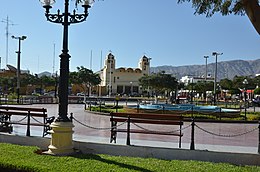This article needs additional citations for verification. (February 2013) |
Nazca | |
|---|---|
| Coordinates: 14°49′44″S 74°56′37″W / 14.82889°S 74.94361°W | |
| Country | |
| Region | Ica |
| Province | Nazca |
| Founded | 17 November 1591 |
| Government | |
| • Mayor | Julio Oscar Elías Lucana |
| Elevation | 520 m (1,710 ft) |
| Population | |
| • Estimate (2015)[1] | 39,054 |
Nazca (/ˈnɑːskɑː, -kə/; sometimes spelled Nasca; Quechua: Naska) is a city and system of valleys on the southern coast of Peru. The city of Nazca is the largest in the Nazca Province. The name is derived from the Nazca culture, which flourished in the area between 100 BC and AD 800. This culture was responsible for the Nazca Lines and the ceremonial city of Cahuachi. They also constructed additional underground aqueducts, named puquios,[2] in a regional system that still functions today. The first puquios are believed to have been built by the preceding Paracas culture.
Nazca is the capital of the Nazca Province located in the Ica District of the Ica Region of Peru.
- ^ Perú: Población estimada al 30 de junio y tasa de crecimiento de las ciudades capitales, por departamento, 2011 y 2015. Perú: Estimaciones y proyecciones de población total por sexo de las principales ciudades, 2012-2015 (Report). Instituto Nacional de Estadística e Informática. March 2012. Retrieved 2015-06-03.
- ^ Lane, Kevin (2016). "Chapter 27 Puquios and Aqueducts in the Central Andes of South America". Underground Aqueducts Handbook. p. 465.








